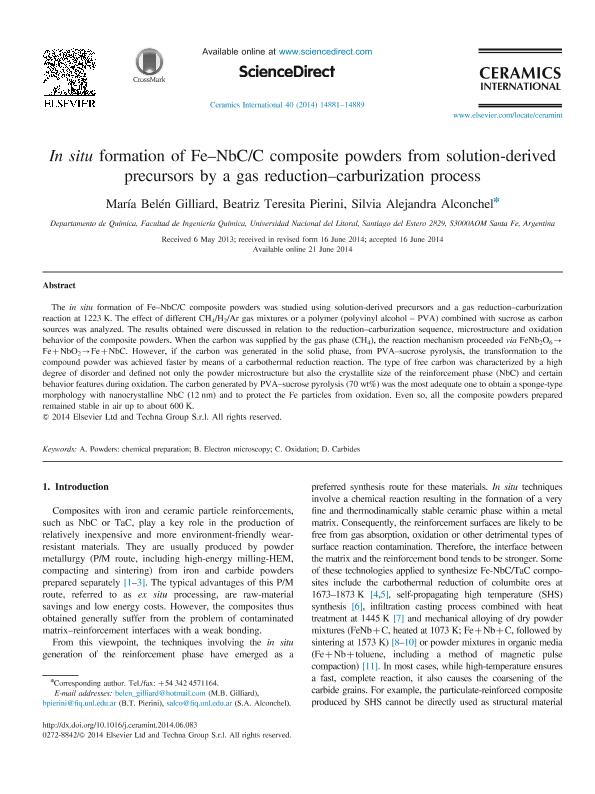Mostrar el registro sencillo del ítem
dc.contributor.author
Gilliard, María Belén

dc.contributor.author
Pierini, Beatriz Teresita
dc.contributor.author
Alconchel, Silvia Alejandra
dc.date.available
2017-12-18T18:01:45Z
dc.date.issued
2014-06
dc.identifier.citation
Alconchel, Silvia Alejandra; Pierini, Beatriz Teresita; Gilliard, María Belén; In situ formation of Fe–NbC/C composite powders from solution-derived precursors by a gas reduction–carburization process; Elsevier; Ceramics International; 40; 9, Parte B; 6-2014; 14881-14889
dc.identifier.issn
0272-8842
dc.identifier.uri
http://hdl.handle.net/11336/30902
dc.description.abstract
The in situ formation of Fe–NbC/C composite powders was studied using solution-derived precursors and a gas reduction–carburization reaction at 1223 K. The effect of different CH4/H2/Ar gas mixtures or a polymer (polyvinyl alcohol – PVA) combined with sucrose as carbon sources was analyzed. The results obtained were discussed in relation to the reduction–carburization sequence, microstructure and oxidation behavior of the composite powders. When the carbon was supplied by the gas phase (CH4), the reaction mechanism proceeded via FeNb2O6→Fe+NbO2→Fe+NbC. However, if the carbon was generated in the solid phase, from PVA–sucrose pyrolysis, the transformation to the compound powder was achieved faster by means of a carbothermal reduction reaction. The type of free carbon was characterized by a high degree of disorder and defined not only the powder microstructure but also the crystallite size of the reinforcement phase (NbC) and certain behavior features during oxidation. The carbon generated by PVA–sucrose pyrolysis (70 wt%) was the most adequate one to obtain a sponge-type morphology with nanocrystalline NbC (12 nm) and to protect the Fe particles from oxidation. Even so, all the composite powders prepared remained stable in air up to about 600 K.
dc.format
application/pdf
dc.language.iso
eng
dc.publisher
Elsevier

dc.rights
info:eu-repo/semantics/openAccess
dc.rights.uri
https://creativecommons.org/licenses/by-nc-sa/2.5/ar/
dc.subject
Powders: Chemical Preparation
dc.subject
Electron Microscopy
dc.subject
Oxidation
dc.subject
Carbides
dc.subject.classification
Otras Ciencias Químicas

dc.subject.classification
Ciencias Químicas

dc.subject.classification
CIENCIAS NATURALES Y EXACTAS

dc.title
In situ formation of Fe–NbC/C composite powders from solution-derived precursors by a gas reduction–carburization process
dc.type
info:eu-repo/semantics/article
dc.type
info:ar-repo/semantics/artículo
dc.type
info:eu-repo/semantics/publishedVersion
dc.date.updated
2017-12-18T15:02:13Z
dc.journal.volume
40
dc.journal.number
9, Parte B
dc.journal.pagination
14881-14889
dc.journal.pais
Países Bajos

dc.journal.ciudad
Ámsterdam
dc.description.fil
Fil: Gilliard, María Belén. Consejo Nacional de Investigaciones Científicas y Técnicas. Centro Científico Tecnológico Conicet - Santa Fe. Instituto de Investigaciones en Catálisis y Petroquímica "Ing. José Miguel Parera". Universidad Nacional del Litoral. Instituto de Investigaciones en Catálisis y Petroquímica "Ing. José Miguel Parera"; Argentina. Universidad Nacional del Litoral. Facultad de Ingeniería Química. Departamento de Química; Argentina
dc.description.fil
Fil: Pierini, Beatriz Teresita. Universidad Nacional del Litoral. Facultad de Ingeniería Química. Departamento de Química; Argentina
dc.description.fil
Fil: Alconchel, Silvia Alejandra. Universidad Nacional del Litoral. Facultad de Ingeniería Química. Departamento de Química; Argentina
dc.journal.title
Ceramics International

dc.relation.alternativeid
info:eu-repo/semantics/altIdentifier/url/http://www.sciencedirect.com/science/article/pii/S027288421400978X
dc.relation.alternativeid
info:eu-repo/semantics/altIdentifier/doi/http://dx.doi.org/10.1016/j.ceramint. 2014.06.083
Archivos asociados
